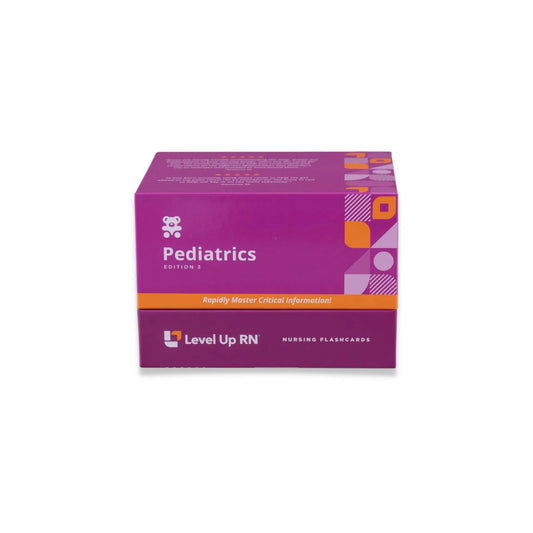- 0:00 What to Expect
- 0:33 Trisomy 21
- 0:50 Risk Factors
- 1:01 Signs and Symptoms
- 1:53 Complications
- 2:09 Diagnosis
- 2:27 Treatment
- 2:52 Nursing Care
- 3:05 Fragile X
- 3:33 Physical Features
- 3:45 Signs and Symptoms
- 3:55 Diagnosis | Treatment
- 4:29 Duchenne’s Muscular Dystrophy
- 4:51 Risk Factors
- 5:04 Signs and Symptoms
- 5:26 Diagnosis
- 5:45 Quiz Time!
Peds, part 38: Nervous Disorders - Trisomy 21, Fragile X, Duchenne's Muscular Dystrophy
Updated: Cathy Parkes
Full Transcript: Peds, part 38: Nervous Disorders - Trisomy 21, Fragile X, Duchenne's Muscular Dystrophy
Full Transcript: Peds, part 38: Nervous Disorders - Trisomy 21, Fragile X, Duchenne's Muscular Dystrophy
Hi. I'm Cathy with Level Up RN. In this video, I'm going to continue my coverage of pediatric nervous system disorders. Specifically, I will be talking about genetic disorders such as Down syndrome, fragile X, and Duchenne's muscular dystrophy. And at the end of the video, I'm going to give you guys a little quiz to test your knowledge of some of the key points I'll be covering in this video, so definitely stay tuned for that. And if you have our Level Up RN pediatric nursing flashcards, pull those out so you can follow along with me.
First up, let's talk about Trisomy 21, which is Down syndrome. This is a chromosomal disorder that results in physical and developmental delays. With this genetic disorder, the child ends up with an extra copy of chromosome 21. Risk factors include a family history, as well as advanced maternal age or advanced paternal age at the time of conception. Signs and symptoms are numerous, and I've listed a lot of the major ones here on the card. I will just hit some of the highlights here in the video. So in terms of physical features associated with Down syndrome, we often see a broad, flat nose, low-set ears, as well as a protruding tongue. The child will also often have a single uninterrupted palmar crease. So if you look at my palm, you'll see these partial creases here that do not extend across the entire palm. With Down syndrome, we often see a single crease that goes across the entire palm. Children with Down syndrome often have a number of GI disorders as well, including GERD, Hirschsprung's disease, celiac disease, as well as constipation. Other complications include seizures, hearing and vision issues, as well as congenital heart defects. And then children with Down syndrome often have intellectual and developmental disabilities as well.
So the diagnosis of Down syndrome can actually be done in the prenatal period using prenatal testing and screening. So when we have a decrease in AFP, then that is often indicative of the presence of a chromosomal disorder such as Down syndrome. Treatment is really focused on the management of symptoms because there is no cure for Down syndrome. So the child will need to see a number of specialists along the way. So they will need to see a GI specialist; possibly a cardiologist. They'll need to work with PT and OT, as well as speech therapy, etc. In terms of nursing care, we want to provide support to the family of a child with Down syndrome. We want to provide educational materials and information on support groups and counseling for the family.
Next let's talk about fragile X, which is a chromosomal abnormality that causes intellectual disability as well as autism. So this is a X-linked dominant genetic disorder that causes a mutation on the X chromosome, so a fragile site on the X chromosome. And males will get much more severe symptoms than females when it comes to fragile X. So physical features associated with fragile X include a long face, a prominent forehead, as well as protruding ears. Other signs and symptoms of fragile X include cognitive impairment, speech abnormalities, poor eye contact, as well as hyperactivity. We can diagnose this genetic disorder during the prenatal period using screening and testing. In terms of treatment, really, our treatment is focused on management of symptoms because there is no cure for fragile X. So we can provide medications such as antidepressants and antipsychotics, as well as ADHD medications, to help control symptoms. In addition, as the nurse, you want to provide referrals for speech, behavioral, as well as occupational therapy for the child.
Finally, let's touch on Duchenne's muscular dystrophy, which is a hereditary neuromuscular disease that causes muscle degeneration and weakness. This is an X-linked recessive disorder that causes both atrophy of the skeletal muscles, but also of the heart muscle. So risk factors include a family history. Males are much more likely to get Duchenne's muscular dystrophy. It is very rare for a female to get Duchenne's muscular dystrophy. Symptoms include delayed motor movement as well as cognitive impairment, muscle weakness, and a waddling gait. We will also see an elevation in creatinine kinase, so CK, because that is an enzyme that is elevated within the presence of muscle degeneration, which is something we have with Duchenne's muscular dystrophy. We can diagnose this condition with genetic testing. There is no cure for Duchenne's muscular dystrophy, and it's going to be important to initiate palliative care. Death usually occurs in the 20s due to respiratory muscle weakness and/or cardiomyopathy.
All right, it's quiz time. Are you guys ready for your questions? I have three questions for you. First one. What X-linked genetic disorder causes intellectual disability and autism? The answer is fragile X. Question number two. Physical features such as low-set ears, a broad, flat nose, and a protruding tongue are associated with what genetic disorder? The answer is Trisomy 21 or Down syndrome. Question number three. What X-linked genetic disorder causes muscle degeneration? The answer is Duchenne's muscular dystrophy. All right, that's it. I hope you enjoyed this video and learned a lot. If so, be sure to like this video and leave me a comment, and if you haven't already done so, be sure to subscribe to our channel. Take care.



2 comments
Excellent examples. Can a child have both Trisomy 21 and Fragile X.
excellent